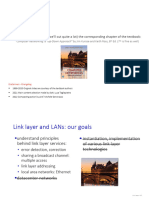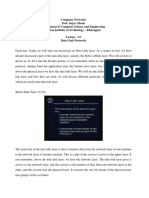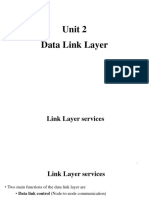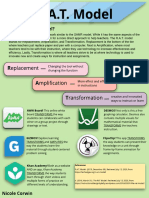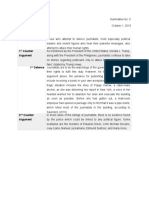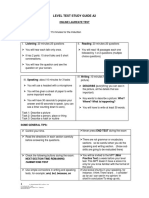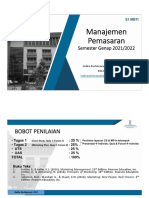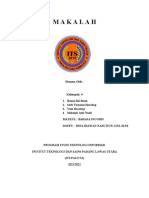Computer Networks
5. Data Link Layer
Lszl Bszrmnyi
Computer Networks
Link Layer - 1
�Nodes and Links
link
Hosts and routers are nodes
Comm. channels connecting
adjacent nodes are links
Wired and wireless links
LANs
A 2-PDU (L-PDU) is a frame,
encapsulates a datagram
Path over different link
protocols over different links
Ethernet WLAN Ethernet
data-link layer has responsibility of
transferring datagram from one node
to an adjacent node over a single link
Lszl Bszrmnyi
Computer Networks
Link Layer - 2
�Link Layer Services
Framing, link access
Encapsulate datagram into frame, adding header, trailer
Channel access if shared medium (MAC)
Media Access Control protocols
Physical addresses used in frame headers to identify
source and destination
Different from IP address!
Reliable delivery between adjacent nodes
Transport layer learned a lot from the link layer (frame
numbering and retransmission if necessary)
Seldom used on low bit error link (fiber, some twisted pair)
Wireless links: high error rates
Lszl Bszrmnyi
Computer Networks
Link Layer - 3
�Link Layer Services (more)
Flow Control
Sliding window protocols (as in the transport layer)
Error Detection
Errors caused by signal attenuation, noise.
Receiver detects presence of errors:
Signals sender for retransmission or drops frame
Error Correction
Receiver identifies and corrects bit error(s) without
resorting to retransmission
Half-duplex and full-duplex
With half duplex, nodes at both ends of link can
transmit, but not at same time
Lszl Bszrmnyi
Computer Networks
Link Layer - 4
�Adapters Communicating
datagram
sending
node
frame
frame
adapter
adapter
Link layer implemented in
adapter (aka NIC)
Receiving side
Ethernet card, PCMCI card,
802.11 card
Sending side:
Encapsulates datagram in a
frame
Adds error checking bits, rdt,
flow control, etc.
Lszl Bszrmnyi
rcving
node
link layer protocol
Looks for errors, rdt, flow
control, etc
Extracts datagram, passes to
the receiving node
Adapter is semi-autonomous
Link & physical layers
Computer Networks
Link Layer - 5
�Error Detection
EDC= Error Detection
and Correction bits
(redundancy)
D = Data protected
by error checking, may
include header fields
Error detection not 100% reliable!
Protocol may miss some errors, but rarely
Larger EDC field yields better detection and correction
Lszl Bszrmnyi
Computer Networks
Link Layer - 6
�Parity Checking
Single Bit Parity:
Detect single bit errors
Two Dimensional Bit Parity:
Detect and correct single bit errors
Even (odd) parity
scheme
# of 1s in d+1 bits is
always even (odd)
Receiver checks this
Can detect 1 bit error
Insufficient for usual
error-bursts
Lszl Bszrmnyi
Computer Networks
Link Layer - 7
�Cyclic Redundancy Check (CRC)
View data bits, D, as a binary number
Choose r+1 bit pattern (generator), G, leftmost bit being 1
Goal: choose r CRC bits, R, such that
<D,R> (d + r) exactly divisible by G (modulo 2, no carries: +,- XOR)
D*2r XOR R = n*G D*2r = n*G XOR R R = remainder(D*2r / G)
Receiver knows G, divides <D,R> by G
If non-zero remainder: error detected!
Can detect all burst errors less than r+1 bits
Widely used in practice (ATM, HDLC); 8,12,16,32 bit G-s
Lszl Bszrmnyi
Computer Networks
Link Layer - 8
�CRC Example
Want:
D.2r XOR R = nG
equivalently:
D.2r = nG XOR R
equivalently:
if we divide D.2r by G,
want remainder R
R = remainder[
Lszl Bszrmnyi
D.2r
G
Transmitted
d+r (9) bits:
101110 | 011
Computer Networks
Link Layer - 9
�Bit Stuffing in general
Special pattern at start and end of frame
Flag: <01111110> (7EH) (contains 6 consecutive 1s)
Data transparency requirement
Data field must be allowed to include flag pattern
If the data contains 7EH, change it in a predefined way
Sender (hardware)
Adds (stuffs) an additional 0 bit after each 5
consecutive 1s
Receiver (hardware)
Sees 5 1 bits, followed by a 0: destuff the 0 bit
If no hardware support: use Byte Stuffing in sw.
Lszl Bszrmnyi
Computer Networks
Link Layer - 10
�Bit Stuffing example
7
Lszl Bszrmnyi
10
5
Computer Networks
10
Link Layer - 11
�Point to Point Data Link Control
One sender, one receiver, one link
Easier than broadcast link
No Media Access Control
No need for explicit MAC addressing
E.g., dialup link, ISDN line
Popular point-to-point DLC protocols:
PPP (point-to-point protocol)
HDLC: High level data link control
Advanced error detection and retransmission
mechanisms
Lszl Bszrmnyi
Computer Networks
Link Layer - 12
�PPP Design Requirements [RFC 1557]
Packet framing
Encapsulation of any NL (not only IP) datagr. in DL frame
Ability to demultiplex upwards
Bit transparency
Must carry any bit pattern in the data field
May use byte-stuffing instead of bit-stuffing
Error detection (no correction)
Multiple types of links
Connection aliveness
Detect, signal link failure to network layer
Network layer address negotiation
Endpoints can learn/set each others network address
Lszl Bszrmnyi
Computer Networks
Link Layer - 13
�PPP non-requirements
No error correction/recovery
No flow control
Out of order delivery OK
No need to support multipoint links (e.g., polling)
Error recovery, flow control, data re-ordering
all relegated to higher layers!
Lszl Bszrmnyi
Computer Networks
Link Layer - 14
�PPP Data Frame
Flag
Every frame begins and ends with a flag byte (framing)
Address and Control
Currently do nothing and can be omitted
Protocol
Upper layer protocol (e.g, PPP-Link Control Protocol
(LCP), IP, IP Control Protocol (IPCP), AppleTalk, etc)
Default max. length for info: 1500 bytes
Lszl Bszrmnyi
Computer Networks
Link Layer - 15
�Multiple Access Links and Protocols
Point-to-point links
E.g. PPP for dial-up access, or point-to-point link
between Ethernet switch and host
Broadcast links (shared wire or medium)
E.g. traditional Ethernet, or 802.11 wireless LAN (WiFi)
Lszl Bszrmnyi
Computer Networks
Link Layer - 16
�Multiple Access (MAC) Protocols
Single shared broadcast channel
Access must be regulated
If two or more nodes transmit simultaneously:
interference
Only one node can send successfully at a time
Multiple access protocol
Distributed algorithm that determines how nodes share
channel, i.e., determine when a certain node can transmit
Communication about channel sharing must use the
same channel!
Lszl Bszrmnyi
Computer Networks
Link Layer - 17
�Ideal Multiple Access Protocol
Assume a broadcast channel of rate R bps
The ideal requirement is
1. When 1 node transmits, it can send at rate R
2. When M nodes want to transmit, each can send
at an average rate R/M (fairness)
3. Fully decentralized
No special node to coordinate transmissions
No synchronization of clocks, no time-slots
4. Simple
Lszl Bszrmnyi
Computer Networks
Link Layer - 18
�General MAC Protocol Classes
1. Channel Partitioning
Divide channel into smaller pieces
(time slots, frequency or code division)
Allocate piece to node for exclusive use
2. Random Access
Channel not divided, allow collisions
Recover from collisions
3. Taking turns
Tightly coordinate shared access to avoid collisions
Lszl Bszrmnyi
Computer Networks
Link Layer - 19
�Channel Partitioning MAC protocols: TDMA
TDM (Time Division Multiplexing)
Channel divided into N time slots, one per user;
TDMA (Time Division Multiple Access )
Access to channel in "rounds"
Each station gets fixed length slot
(length = frame transmission time) in each round
Unused slots go idle
Example: 6-station LAN, 1,3,4 have frame, slots 2,5,6 idle
Lszl Bszrmnyi
Computer Networks
Link Layer - 20
�Channel Partitioning MAC protocols: FDMA
Channel spectrum divided
into frequency bands
Each station assigned
fixed frequency band
Unused transmission time
in frequency bands go idle
Example: 6-station LAN,
1,3,4 have pkt, frequency
bands 2,5,6 idle
Lszl Bszrmnyi
frequency bands
FDMA (Frequency
Division Multiple Access)
Computer Networks
Link Layer - 21
�Channel Partitioning MAC protocols: CDMA
CDMA (Code Division Multiple Access)
Senders may send simultaneously, coding helps to
separate different sources
All users share same frequency, but each user has own
chipping sequence (i.e., code) to encode data
Allows code set partitioning (if codes are orthogonal)
Used mostly in wireless broadcast channels (cellular,
satellite, etc)
The code needs high frequency (chipping frequency)
Encoded signal = (original data) X (chipping sequence)
Decoding: inner-product of encoded signal and chipping
sequence
Multiple users can coexist with minimal interference
Lszl Bszrmnyi
Computer Networks
Link Layer - 22
�CDMA Encode/Decode
di: ith data bit
cm: mth bit of the
code
Zi,m : mth bit of
the encoded
data bit
Makes no
sense with
one single
sender-receiver
pair
Lszl Bszrmnyi
Computer Networks
Link Layer - 23
�CDMA: two-sender interference
Additive signals
E.g if 4 senders
send 1,1,1,-1:
The received
signal is 2
Receiver gets
the sum of all
channels: Z*
Each receiver
can recover its
channel, if the
codes are
chosen
orthogonally
Lszl Bszrmnyi
Computer Networks
Link Layer - 24
�Random Access Protocols
When node has packet to send
Transmit at full channel data rate R
No a priori coordination among nodes
Two or more transmitting nodes collision
Random access MAC protocol specifies:
How to detect collisions
How to recover from collisions (e.g., via delayed
retransmissions)
Examples of random access MAC protocols:
ALOHA and slotted ALOHA
CSMA, CSMA/CD (Ethernet), CSMA/CA
Lszl Bszrmnyi
Computer Networks
Link Layer - 25
�Slotted ALOHA
Assumptions
Operation
All frames same size (L)
Time is divided into
equal size slots (L/R),
time to transmit 1 frame
Nodes start to transmit
frames only at beginning
of slots
Nodes are synchronized
If 2 or more nodes
transmit in the same slot,
all nodes detect collision
Lszl Bszrmnyi
When node obtains fresh
frame, it transmits in next
slot
No collision: node can send
new frame in next slot
If collision, node
retransmits frame in each
subsequent slot with
probability p until success
Toss a coin, probability of
head: p, tails: 1-p
If head: retransmit
If tails: skip the slot
Computer Networks
Link Layer - 26
�Slotted ALOHA
Slot evenets
Cons
Pros
Single active node can
continuously transmit
at full rate of channel
Highly decentralized:
only slots in nodes
need to be in sync
Simple
Lszl Bszrmnyi
Collisions and wasting
slots
Empty (idle) slots
Nodes may be able to
detect collision in less
than time to transmit
packet
Computer Networks
Link Layer - 27
�Slotted Aloha efficiency
Efficiency is the long-run
fraction of successful slots
when theres many nodes, each
with many frames to send
Suppose N nodes with many
frames to send, each
transmits in a given slot with
probability p
Probability that others do not
transmit: (1-p)N-1
Probability of success of one
node in a slot = p(1-p)N-1
Probability that any node has
a success = Np(1-p)N-1
Lszl Bszrmnyi
For max efficiency with
N nodes, find p that
maximizes Np(1-p)N-1
For many nodes, take
limit of Np*(1-p*)N-1 as N
goes to infinity
Gives: 1/e = .37
(e: natural logarithm)
Computer Networks
At best: channel
used for useful
transmissions 37%
of time!
Link Layer - 28
�Pure (unslotted) ALOHA
Unslotted Aloha: simpler, no synchronization
When frame first arrives
Transmit immediately
Collision probability increases
Frame sent at t0 may collide with other frames sent in [t0-1,t0+1]
Efficiency: half of that of slotted ALOHA: 18%
Lszl Bszrmnyi
Computer Networks
Link Layer - 29
�CSMA (Carrier Sense Multiple Access)
spatial layout of nodes
CSMA
If channel sensed idle:
transmit entire frame
If channel sensed busy:
defer transmission
Collisions can still
occur
Two nodes may not
hear each others
transmission due to
propagation delay
Entire transmission time
wasted
Lszl Bszrmnyi
Computer Networks
Link Layer - 30
�CSMA/CD (CSMA+Collision Detection)
CSMA/CD
Collisions detected fast
Colliding transmissions
aborted
Wasted time shorter
Collision detection:
Easy in wired LANs
Compare transmitted and
received signals
Difficult in wireless
LANs
Lszl Bszrmnyi
Computer Networks
Link Layer - 31
�Taking Turns MAC protocols
Channel partitioning MAC protocols:
Share channel efficiently and fairly at high load
Inefficient at low (resp. bursty) load:
Delay in channel access
1/N bandwidth allocated even if only 1 active node!
Random access MAC protocols
Efficient at low (resp. bursty) load
Single node can fully utilize channel
High load
Collision overhead
Taking turns protocols
Look for best of both worlds!
Lszl Bszrmnyi
Computer Networks
Link Layer - 32
�Taking Turns MAC protocols
Polling:
Master node
invites slave nodes
to transmit in turn
Concerns:
polling overhead
latency
single point of failure
(master)
Lszl Bszrmnyi
Token passing:
Control token passed from one
node to next sequentially
Token owner may send
(for a limited time)
Token message
Concerns:
token overhead
latency
token may get lost: must be
regenerated, but never duplicated
Computer Networks
Link Layer - 33
�Summary of MAC protocols
What do we do with a shared media?
Channel Partitioning, by time, frequency or code
Time Division, Frequency Division, Code Division
Random partitioning (dynamic),
ALOHA, S-ALOHA, CSMA, CSMA/CD
Carrier sensing: easy in some technologies (wire), hard
in others (wireless)
CSMA/CD used in Ethernet
Taking Turns
polling from a central site
token passing
Lszl Bszrmnyi
Computer Networks
Link Layer - 34
























